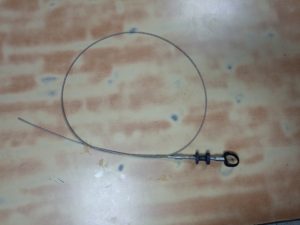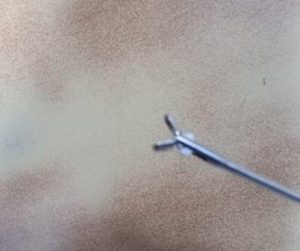Used to collect the tissue the digestive tract, upper airways trachea bronchial tree, female reproductive organs, and urinary organs. Biopsy forceps in Endoscopy Endoscopy with a port for the instruments like Forceps and irrigation on the side port.
Using incompatible equipment can result in patient injury or equipment damage.
Basic components of the Endoscopy instruments
- The shape of the cups
- Maximum insertion portion diameter in mm
- Working length in mm
- Instruments with needle or not
- Fenestration cups or without fenestration
- Compatible endoscopes
- Channel inner diameter
- Color code
- Working length
Indication
Used in Collection of the sample, biopsy foreign body removal, and Polypectomy, etc.
- Upper Gastrointestinal Endoscopy
- Colonoscopy
- Sigmoidoscopy
- Fiber optic bronchoscopy
- Endoscopy
Caution notes indicate a potentially hazardous situation which, if not avoided may result in minor or moderate injury .it may also be used to alert against unsafe practices or potential equipment damage
Types of Biopsy forceps in Endoscopy
Alligator forceps

Standard cup type biopsy forceps
Standard cup type with needle
Rat tooth forceps with fenestrated cups
Rat tooth forceps with alligator types (swinging types)
Working lengths with less than
1100mm
2050mm
2250mm
1600mm
1350mm
2300mm
1950mm
1550mm
1800mm
1500mm
| Color code | Inner diameter in mm |
| Orange | 3.7mm,4.2mm,6mm |
| Pink | 5.5mm |
| Blue | 2mm,2.2mm |
| Green | 2.6mm |
| Yellow | 2.8mm,3.2mm |
| Violet | 1.7mm |
Keep on inspecting the instruments any damage and irregularity may compromise patients or user safety such as
Infection
Control risk
Tissue irritation
Perforation
Bleeding
Mucous membrane damage
Severe equipment damage
how to Endoscope Forceps in Endoscope
Before use, confirm that the pins are fully seated at the forceps at the distal end in the normal position
It should be in the normal position
Do not bend or twist the forceps distal end to avoid the injury to the patients.
It should not protrude out in abnormal positions.
When using the instruments (standard cup forceps) with a needle be careful, don’t touch the needle.
Take a precaution during handling of the needle tips
Infectious substances attached to the needle such as the patient’s blood mucous could pose the infection control risk and may cause patient injury.
Before using the instruments inspect well and confirm the distal tip of the forceps is not corroded or discolored.
When using the instruments always wear appropriate personal equipment. otherwise blood mucous and other potentially infection materials from the patients could pose an infection control risk.
Caution
Do not insert the instruments into the endoscopy unless you have a clear endoscopic field of view.
When using the instruments with two-channel endoscopy never use the Electrosurgical accessories at the same time. This will be a potential injury to the operator or the assistant such as the thermal injury.
Do not force the endoscopic instruments if there is a resistance to the insertion is encountered
Reduce the angulation until the instruments pass smoothly.
Do not coil the insertion port less than 15 cm.
Never use any other instruments or external force to open or close the tips of the instrument
Personal Protective Equipment
Operating personnel must wear personal protective wearing to avoid the infection to them.
Wear eye protective goggles, face mask, moisture-resistant clothing, chemical resistant gloves must be worn during all the endoscopic procedures.
Inspection of Endoscopy instruments
Inspection of the sterile packs before opening.
Inspect the sterile package for tears, inadequate sealing, or water damage. if a sterile package shows any irregularities, use any other fresh pack instead of that.
While operating the slides to open and close the cups, confirm that the instruments, free from disconnection or looseness.
Make sure that the cups are close evenly and are properly aligned when the slider is pulled.
When using instruments with a needle push the slider to open and confirm the needle is not detached or bent conspicuously.
Gently run your fingertips over the entire length of the insertion portion to check for any crushed areas excessive bands etc.
Loop insertion must be less than 20 cm in diameter
Move the slider and confirm that the cups open and close smoothly.
The operator of the instruments must be a physician or medical professional under the supervision of the physician and must have received sufficient training in the clinical endoscopy techniques.
Patients risk and cautions
Patient’s injury such as perforation, bleeding, or mucous membrane damage.
When inserting the instruments into the endoscope, hold it close to the biopsy valve or t plug and keep it straight as possible relative to the biopsy or t plug.
Before insertion of the instruments, open the biopsy valve, and when inserting hold the distal end closed.
Do not withdraw the instruments from the endoscopy quickly. This could scatter blood, mucous, or other patient’s debris.
Collection of the sample tissue
Do not force the distal end of the insertion portion against body cavity tissue.
When performing biopsy the collected tissue may be dropped inside the trachea.
If there is bleeding, select the hemostatic device like bipolar diathermy, hemostatic agents.
To collect the target tissue angulate the bending section or advance the instruments until reaches the target site.
Push the slider to open the cups
Press the open the cups against the target tissue
Pull the slider to collect the target tissue.
Ambient temperature 10 – 40-degree centigrade (50-104 degree F)
Relative humidity of 30-85 %
Air pressure 700-10160 hPa